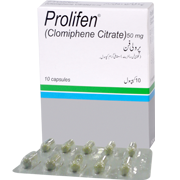
Prolifen Dosage in 2nd Cycle of the Treatment
If ovulation occurs with this dose there is no need to increase Prolifen dosage in the following treatment cycles. If after the first test cycle ovulation does not occur, a second treatment cycle can be started after 30 days of the first one, lasting for 5 days with Clomiphene 100 mg (2 Prolifen capsules) a day in two doses between meals. Prolifen Dosage must never be higher than 100 mg/day and treatment has not to be continued for more than 5 days.
If necessary, a third treatment cycle may be given in the same manner. Most of the carefully selected patients will have ovulation during the first cycle. Amenorrhea lasting for a few years might make the endometrium less sensitive, and two or three cycles might be necessary.
Three treatment cycles of Prolifen may be a sufficient therapeutic test. Ovulation is rarely obtained after 3 cycles of unsuccessful treatment. If ovulatory menses are not obtained after three treatment cycles it is advisable to re-examine the diagnosis.
Once ovulation has occurred, to achieve a regular ovulatory cycle it is important to start each treatment cycle on the 5th day of the menstrual cycle. The number of treatment cycles must be determined by the physician.
If pregnancy does not occur after 6 treatment cycles, it is unlikely that another cycle will be successful and further treatment is not recommended. Patients who wish to become pregnant should be informed of the great importance of selecting the appropriate time for coitus.
As it still has not been demonstrated that prolonged cyclic treatment does not have side effects, Prolifen must not be administered as a monthly maintenance treatment in patients who fail to ovulate when treatment is suspended. In patients with amenorrhea or oligomenorrhea, treatment with Prolifen if effective, restores regular menses with ovulation.
A simple and relatively safe method to establish whether ovulation has taken place even in patients under treatment for anovulatory hemorrhage, is to measure the temperature increase that occurs during the luteal phase (basal temperature). It can be considered that ovulation has occurred if the patient has found an increase in the basal temperature which is maintained for 10-12 days and followed by menses.
The presence of menses not preceded by the normal increase in basal temperature or a prolonged increase in temperature not followed by menses, must be considered as a negative response. To avoid the administration of Prolifen during the first period of pregnancy, if the basal temperature is biphasic and is not followed by menses, it is necessary to examine the patient carefully to determine the presence of an ovarian cyst and carry out a pregnancy test. The next treatment cycle must not be started until an exact diagnosis has been made. The basal temperature test may be completed with a cervical smear, vaginal cytology and biopsy of the endometrium.
Related Links
Is prolifen capsule safe to use if having ovarian hyperstimulation syndrome as I am having difficulty in conceiving kindly reply if anyone knows?
Hello Misbah,
The content published on these pages is for information purposes only. Do not take this as an alternate to a medical advice.
Always ask your physician before taking any medication including Prolifen Capsules.
Thanks!
Nice answer i must recommend miss misbah to consult gynecologist.
can male also take this medication as booster for testosterone level?
patien is 26 old male having low body and face hair. with gynecomastia
please reply fast i having serious anxiety and depression due to this condition
I am married last year 7 feb 2016 nd i want to concieve but cant… dr give me prolifen capsule nd i take it 5 days of periods nd now my breast hurt nd swollen…increase urination plzzz tell me am i pregnant???
Hello.
I m taking this medicine from two months. Last month my dr advice me to take 3 prolifen medicine per day start from the 2nd day of my periods. By taking this my follical size was 27.7. Now this is the 3rd month and i have periods spoting start. I am worry if this follical may turn into cyst due to its oversize.
Kindly guide me.
Hi i have a son 1 and half year at that time i also took treatment now i want to again conception can i use prolifen 50mg twice a day